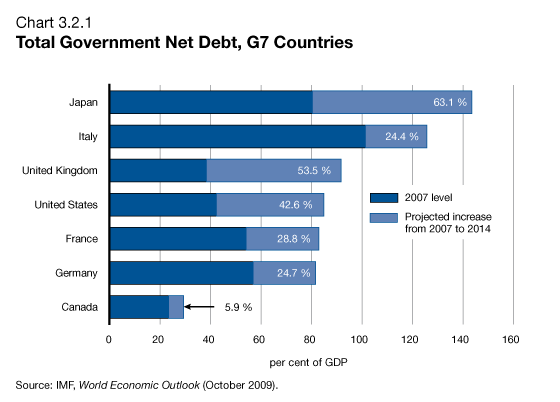Common menu bar links
archived - Chapter 3.2: Sustaining Canada's Economic Advantage
Table of Contents - Previous - Next
The measures in Canada's Economic Action Plan are designed to protect Canadians from the immediate challenges posed by the global recession. These actions will also improve Canada's long-term economic growth and prosperity. By ensuring that Canada emerges from the recession with a more modern infrastructure, a more skilled and flexible labour force, lower taxes and a more competitive economy, the measures in the Action Plan will also contribute to sustaining and building on Canada's economic advantages.
In 2006, the Government set out its long-term plan for the economy in Advantage Canada. Advantage Canada is about building a strong foundation for Canada's economic future by focusing on the main drivers of productivity: human capital, physical capital, and sound regulatory, tax and fiscal frameworks. To that end, the plan is centered on building five key strategic advantages for Canada:
A Tax Advantage—reducing the tax burden on Canadians and Canadian businesses.
A Knowledge Advantage—fostering skills, training and education.
An Infrastructure Advantage—building a modern, world-class infrastructure.
An Entrepreneurial Advantage—making product and financial markets more efficient.
A Fiscal Advantage—strengthening Canada's fiscal position for current and future generations.
Since 2006, the Government has made significant progress in implementing all elements of Advantage Canada.
- The Government has made major progress in developing a Canadian tax advantage: it has reduced taxes in every way that it collects revenues, and is ensuring that Canadian families, students, workers, seniors and businesses large and small continue to keep more of their hard-earned money.
- Building on progress in creating a Tax Advantage, Canada's Economic Action Plan has introduced over $20 billion in new tax relief in 2008–09 and over the following five fiscal years. This will bring total tax relief for individuals, families and businesses from measures introduced since 2006 to an estimated $220 billion over this period.
- This year, Canada will have an overall tax rate on new business investment that is the lowest in the Group of Seven (G7) and below the average of the Organisation for Economic Co-operation and Development (OECD). Canada's business tax advantage is supporting investment, job creation and growth in all sectors of the economy, improving productivity and providing Canadians with more and better jobs.
- By 2012, Canada will have the lowest statutory corporate income tax rate in the G7. With a federal rate of 15 per cent in 2012, and provinces and territories converging towards the goal of a 10-per-cent rate, a 25-per-cent combined federal-provincial corporate income tax rate makes Canada a country of choice for investment.
- The Government introduced the Tax-Free Savings Account—the most important new vehicle for savings since the introduction of the Registered Retirement Savings Plan—which has improved the incentives for all Canadians to save.
- The Government introduced the Working Income Tax Benefit, lowering the "welfare wall", making work more attractive for low-income Canadians.
- Canada's federal tax-to-GDP (gross domestic product) ratio is at its lowest level since 1961.
- To ensure Canada has the best-educated, most-skilled and most flexible workforce in the world, the Government has made significant new investments in education, training, a modernized Canada Student Loans Program, the new Vanier Canada Graduate Scholarships, and innovation, science and technology. Canada's immigration system has also been streamlined to better respond to the needs of the labour market.
- Historic federal infrastructure investments are enhancing Canada's future by increasing productivity and competitiveness, cleaning up the environment and strengthening communities as vibrant centres of commerce, learning and recreation.
- To build a more competitive business environment, the Government has signed bilateral free trade agreements, implemented unilateral tariff reductions and strengthened Canada's financial system.
- All of these achievements are sustainable. In contrast to the situation in other major industrialized countries, Canada's fiscal position is strong. Canada entered the recession with a total government net debt-to-GDP ratio of 23.5 per cent. Looking ahead, Canada's net debt burden is projected to increase by just 5.9 percentage points between 2007 and 2014. This compares to an expected increase of between 24 and 63 percentage points for other G7 nations (Chart 3.2.1).
The Government is committed to maintaining this strong Fiscal Advantage and returning to balanced budgets over the medium term. The Government's plan to return to balance is detailed in Chapter 4. Budget 2010 also introduces a number of targeted actions, at limited fiscal cost, that will provide additional support to the economy by protecting and creating jobs, furthering the objectives of Advantage Canada, and addressing other priorities. These actions are outlined in the next section.

